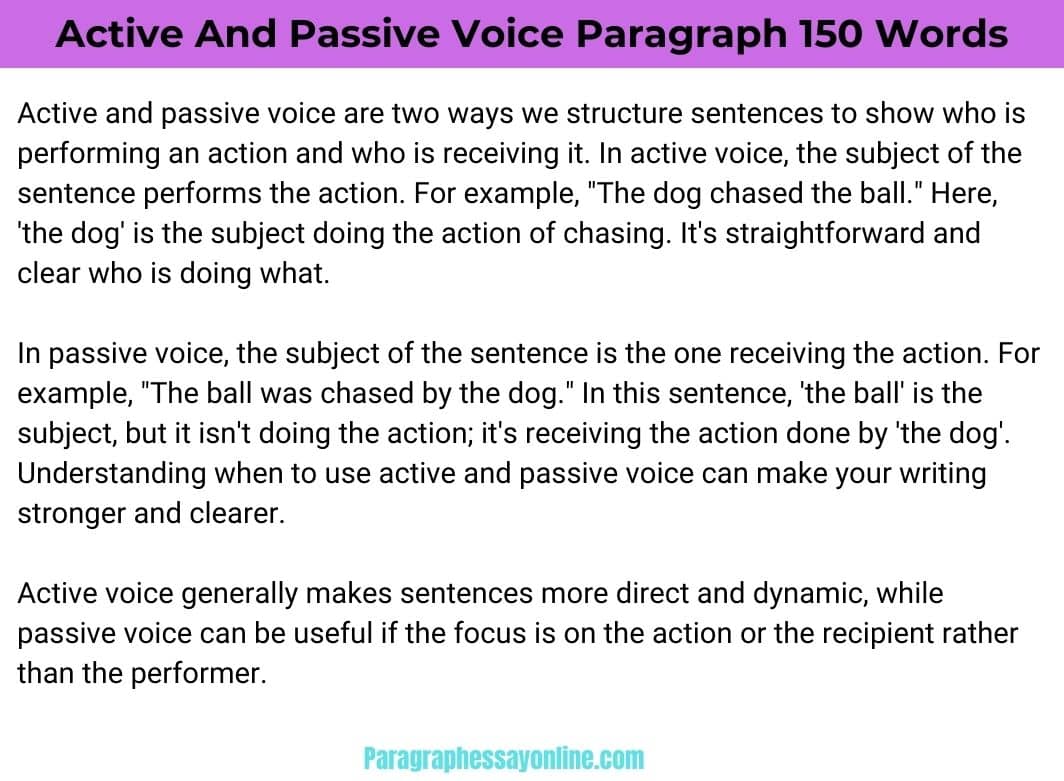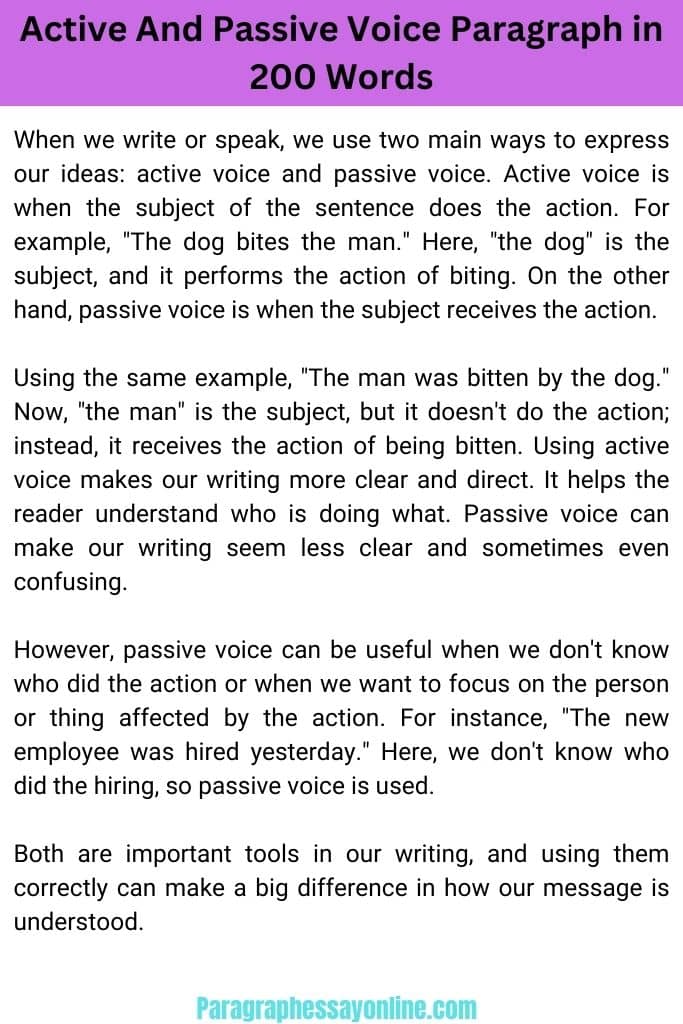Active And Passive Voice Paragraph
Active And Passive Voice Paragraph For All Classes (1-12)
An active and passive voice paragraph explores the differences between these two grammatical constructs. It highlights how active voice emphasizes the subject performing the action, while passive voice focuses on the object receiving the action, and discusses the appropriate use of each in effective writing.
Active And Passive Voice Paragraph 100 Words For 1, 2, 3 Students
Active and passive voice are ways we make sentences. In active voice, the person or thing doing the action comes first in the sentence. For example, “The cat drinks milk.” The cat is doing the action. In passive voice, the person or thing receiving the action comes first. For example, “The milk is drunk by the cat.” Here, the milk is receiving the action.
We use active voice to show who is doing something. We use passive voice when we want to focus more on what is happening to something or someone. Both ways help us make our sentences clear and interesting.
Active And Passive Voice Paragraph in 150 Words For 4 & 5 Students
Active and passive voice are two ways we structure sentences to show who is performing an action and who is receiving it. In active voice, the subject of the sentence performs the action. For example, “The dog chased the ball.” Here, ‘the dog’ is the subject doing the action of chasing. It’s straightforward and clear who is doing what.
In passive voice, the subject of the sentence is the one receiving the action. For example, “The ball was chased by the dog.” In this sentence, ‘the ball’ is the subject, but it isn’t doing the action; it’s receiving the action done by ‘the dog’.
Understanding when to use active and passive voice can make your writing stronger and clearer. Active voice generally makes sentences more direct and dynamic, while passive voice can be useful if the focus is on the action or the recipient rather than the performer.

Active And Passive Voice Paragraph in 200 Words For 6, 7, and 8 Students
When we write or speak, we use two main ways to express our ideas: active voice and passive voice. Active voice is when the subject of the sentence does the action. For example, “The dog bites the man.” Here, “the dog” is the subject, and it performs the action of biting. On the other hand, passive voice is when the subject receives the action.
Using the same example, “The man was bitten by the dog.” Now, “the man” is the subject, but it doesn’t do the action; instead, it receives the action of being bitten. Using active voice makes our writing more clear and direct. It helps the reader understand who is doing what. Passive voice can make our writing seem less clear and sometimes even confusing.
However, passive voice can be useful when we don’t know who did the action or when we want to focus on the person or thing affected by the action. For instance, “The new employee was hired yesterday.” Here, we don’t know who did the hiring, so passive voice is used.
Both are important tools in our writing, and using them correctly can make a big difference in how our message is understood.

Active And Passive Voice Paragraph in 250 Words For 8,9,10 Students
In English grammar, active and passive voice are two essential concepts that help us convey our ideas effectively. Active voice occurs when the subject of the sentence performs the action described by the verb. For example, “The teacher is writing on the board.” Here, “the teacher” is the subject, and it’s doing the action of writing.
On the other hand, passive voice is used when the subject receives the action. Using the same example, “The board is being written on by the teacher.” Now, “the board” is the subject, but it’s not doing the action; instead, it’s receiving the action of being written on. Active voice is generally preferred in writing because it’s more direct and clear.
It helps the reader understand who is doing what and makes the text more engaging. Passive voice, however, can be useful in certain situations. For instance, when we don’t know who performed the action, passive voice is a good choice. It can also be used to emphasize the person or thing affected by the action.
Moreover, passive voice can make our writing seem more formal or objective, which is often necessary in academic or technical writing. Nevertheless, it’s essential to use both active and passive voice correctly and appropriately, depending on the context and purpose of our writing. By mastering active and passive voice, we can express ourselves more effectively and communicate our ideas with clarity and precision.
Active And Passive Voice Paragraph 300 Words For 9, 10, 11, 12 Students
The distinction between active and passive voice is a crucial aspect of English grammar, significantly impacting the clarity and effectiveness of our writing. Active voice occurs when the subject of the sentence performs the action described by the verb, as in “The researchers conducted the experiment.” Here, “the researchers” are the subject, and they’re doing the action of conducting.
In contrast, passive voice is used when the subject receives the action, as in “The experiment was conducted by the researchers.” Now, “the experiment” is the subject, but it’s not doing the action; instead, it’s receiving the action of being conducted. Active voice is generally preferred in most forms of writing because it’s more direct, clear, and engaging. It helps the reader understand who is doing what and makes the text more dynamic. Passive voice, on the other hand, can be useful in specific contexts.
For instance, when the doer of the action is unknown or unimportant, passive voice is a good choice. It can also be used to emphasize the person or thing affected by the action, or to create a more formal or objective tone, often necessary in academic, technical, or scientific writing. Furthermore, the strategic use of active and passive voice can significantly enhance the persuasive power of our writing.
Using passive voice depersonalizes the action, which can be important in scientific fields to maintain an objective tone. Mastery of both voices is crucial for effective communication. It allows writers to adapt their style to the context of their writing, making their arguments more persuasive or their reports more formal.
By choosing the right voice, we can influence how our message is perceived and interpreted by the reader. Therefore, it’s essential to understand the differences between active and passive voice and to use them correctly and effectively in our writing. By doing so, we can communicate our ideas with greater clarity, precision, and impact.
Active And Passive Voice Paragraph in 500 Words For 9, 10, 11, and 12 Students
In the realm of grammar, understanding the active and passive voice is essential for effective communication. Active voice occurs when the subject of the sentence performs the action, as in “The chef cooked a delicious meal.” This structure emphasizes the doer of the action, making the sentence direct and dynamic. In contrast, passive voice shifts the focus to the receiver of the action, as in “A delicious meal was cooked by the chef.” Here, the meal, the receiver of the action, is highlighted instead of the doer.
Active voice is typically more straightforward and engaging. It allows the writer to present ideas clearly and forcefully, making it the preferred choice in many forms of writing, especially in narratives and daily conversations where clarity and engagement are key. For example, “The scientist discovered a new planet” is more direct and impactful than “A new planet was discovered by the scientist.”
However, passive voice has its place in language as well. It is particularly useful in academic, scientific, and formal writings where the focus shifts from the doer to the action or the recipient of the action. In scientific papers, for instance, passive voice helps maintain objectivity and focus on the action and results rather than on the researcher. Sentences like “The data were analyzed” are common because who performed the action is often irrelevant.
Moreover, passive voice is beneficial when the subject is unknown, unimportant, or obvious. For example, in reporting an incident, one might say, “The store was robbed last night.” If the identity of the robbers is unknown, this passive construction is the most effective way to convey the information.
Understanding when and how to use each voice can significantly enhance a student’s writing and speaking abilities. While active voice is generally preferred for its clarity and vigor, knowing how to use passive voice effectively can add variety and sophistication to writing. For example, changing the voice can alter the emphasis in a text, affecting how information is perceived and understood by the audience.
The ability to switch between active and passive voice also reflects a deeper understanding of language structure. This skill is critical for students as they tackle complex writing tasks in higher education and professional environments. For instance, persuasive writing might rely heavily on active constructions to assert strong, clear positions, whereas analytical writing might employ passive structures to emphasize data and results over researchers’ actions.
To master these voices, students should practice rewriting sentences in both active and passive forms. This exercise not only helps in understanding the grammatical structure but also enhances their ability to focus on different elements of a sentence depending on the context and purpose of the writing.
Mastery of both forms empowers students to tailor their language to suit specific purposes and audiences, making their expression more precise, versatile, and impactful. As such, proficiency in using both voices is a valuable skill for academic success and beyond.
Most Important Paragraph:
| Favourite Sportsman Paragraph. |
| Mango Paragraph. |
| River Paragraph. |
| Rising Pollution Paragraph. |
| Paragraph On Diversity. |
Frequently Asked Questions on Active And Passive Voice Paragraph
Q: When should I use active voice?
Use active voice when you want to emphasize who is performing the action or when clarity is essential.
Q: When is passive voice more suitable?
Use passive voice when the doer of the action is unknown, unimportant, or when you want to emphasize the receiver of the action.
Q: How can I identify active voice in a sentence?
Look for the subject performing the action described by the verb.
Q: How can I identify passive voice in a sentence?
Look for the subject receiving the action described by the verb, often with the help of “by” or other prepositions.
Q: Can I mix active and passive voice in the same paragraph?
Yes, but be cautious not to confuse the reader; use transitions to connect your ideas smoothly.
Q: Why is active voice generally preferred in writing?
Active voice is more direct, clear, and engaging, making it easier for readers to understand who is doing what.
